 |
 |
 |
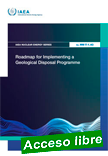 |
Roadmap for Implementing a Geological Disposal Programme
IAEA- STI/PUB/2088 ¦ English ¦ 83 pages ¦ Date published: 2024
Implementation of a geological disposal programme for radioactive waste is a major undertaking. Consideration must be given to the long time over which the programme operates, the technical assurance which needs to be demonstrated to ensure long term safety and security, and the socially and politically sensitive nature of radioactive materials management. This publication provides a roadmap for developing and implementing a geological disposal programme for spent nuclear fuel declared as waste, high level, and intermediate level waste.
|
It identifies the important components and sequences of activities that are the responsibility of the implementing organization to construct and operate a geological disposal repository in a manner consistent with existing international experience. The publication also provides information on how several advanced programmes have progressed along their respective roadmaps toward siting, constructing, and operation a geological repository.
|
 |
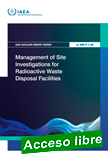 |
Management of Site Investigations for Radioactive Waste Disposal Facilities
IAEA- STI/PUB/2093 ¦ English ¦ 235 pages ¦ Date published: 2024
Radioactive waste arises with all uses of nuclear technologies and requires disposal for its safe long-term management. Site investigations to inform disposal site selection, design, environmental and safety assessment is central to implementing any disposal facility. This publication provides guidance on requirements-driven management of a site investigation programme for disposal and presents a broad range of tried-and-proven technologies used to conduct investigations and obtain required site data.
|
Investigation approaches specific to different types of host rocks are presented and case studies on issues and challenges dealt with by Member States provide lessons learned. This publication will be of interest to senior decision makers, scientists and engineers, technical support organisations and regulatory authorities involved in disposal of radioactive waste.
|
 |
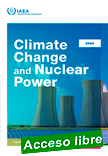 |
Climate Change and Nuclear Power 2024: Financing Nuclear Energy in Low Carbon Transitions
IAEA- CCANP-24 ¦ English ¦ 99 pages ¦ Date published: 2024
The 2024 edition of Climate Change and Nuclear Power delves into the dynamics of financing nuclear projects to unlock much needed nuclear energy capacity as ambitious climate targets draw nearer. We explore the imperative for robust financial frameworks to propel the adoption of nuclear energy as a cornerstone of global decarbonization efforts.
|
This publication seeks to inform those at the intersection of sustainability and finance — climate negotiators, government officials, commercial and multilateral financiers, energy and climate policy makers, experts, non-governmental organizations and media representatives — about the potential of nuclear energy in mitigation and highlight challenges and best practices in financing nuclear projects.
|
 |
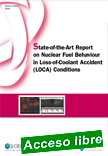 |
State-of-the-Art Report on Nuclear Fuel Behaviour in Loss-of-Coolant Accident (LOCA) Conditions
OECD NEA No. 7683 ¦ English ¦ 596 pages ¦ Date published: 2024
This report established by the NEA Working Group on Fuel Safety (WGFS) of the Committee on the Safety of Nuclear Installations (CSNI) compiles the state-of-the-art knowledge on fuel behaviour in loss-of-coolant accident (LOCA) as of 2018 and constitutes a reference for nuclear fuel safety specialists by providing the technical basis for safety analysis related to LOCA.
|
The report includes the following aspects: description of different LOCA scenarios for major reactor designs: BWRs, PWRs, VVERs and also CANDUs and RBMKs; world-wide LOCA safety criteria; description of LOCA phenomena: ballooning, burst, oxidation, fuel relocation and possible fracture at quench; details of high-temperature oxidation behaviour of various cladding materials; metallurgical phase change, effect of hydrogen and oxygen on residual cladding ductility; methods for LOCA testing; summary results of LOCA-related experiments including separate-effect and integral tests; and predictive computer codes.
|
 |
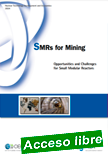 |
SMRs for Mining: Opportunities and Challenges for Small Modular Reactors
OECD NEA No. 7686 ¦ English ¦ 80 pages ¦ Date published: 2024
This publication on small modular reactors (SMRs) for mining is the first of a series of NEA case studies that assess the opportunities and challenges for SMRs to support decarbonisation of hard-to-abate industrial sectors. The mining sector is particularly challenging to decarbonise. However, mining is essential for the clean energy transition, which depends on various critical minerals such as rare earth elements, niobium, lithium, cobalt and copper for energy infrastructure and technologies for generation, storage and transmission.
|
These materials are commonly located in remote areas, underscoring the imperative to decarbonise off-grid mining.
This NEA case study on SMRs for mining was informed by direct engagement with stakeholders in the mining sector, who identified a range of considerations and barriers to SMR adoption at mine sites related to costs, regulatory aspects, public perception, and operational considerations. A near-term opportunity is quantified for small off-grid mines to replace existing diesel or heavy fuel oil generation with micro-SMRs, with immediate implications for critical mineral mining. This publication highlights the potential for SMRs to enable sustainable and cost-effective mining essential for the global clean energy transition.
|
 |
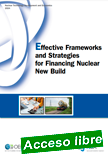 |
Effective Frameworks and Strategies for Financing Nuclear New Build
OECD NEA No. 7686 ¦ English ¦ 92 pages ¦ Date published: 2024
Scaling up investment flows in nuclear energy is one of the major challenges for OECD and NEA countries that have decided or are considering the construction of nuclear power plants. This report offers a comprehensive review of global financing strategies, aiming to establish a common vocabulary and basis for comparative analysis to identify and discuss key lessons learnt about the relative merits of different strategies to finance nuclear projects.
|
. While there are no simple solutions for financing new nuclear projects, this report helps identify the “building blocks” that policymakers and private sector decision makers can leverage to help finance a tripling of nuclear energy by 2050.
|
 |
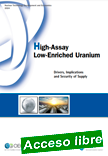 |
High-Assay Low-Enriched Uranium: Drivers, Implications and Security of Supply
OECD NEA No. 7685 ¦ English ¦ 72 pages ¦ Date published: 2024
The potential deployment of small modular reactors (SMRs) is viewed by many countries as a transformative opportunity to support net zero objectives through various power and non-power applications. In this context, high-assay low-enriched uranium (HALEU) fuels, with enrichment levels between 5% and 20%, are expected to play a crucial role.
|
However, commercial HALEU production in OECD countries is limited, and geopolitical uncertainties raise concerns about HALEU supply and potential disruptions to nuclear fuel supply chains. Historically, the nuclear energy industry has operated with enrichment levels up to 5%, with the associated supply chain, legal, and regulatory frameworks designed accordingly. This report aims to support policymakers in NEA member countries with evidence-based analysis on HALEU adoption. It explores the driving forces and implications of HALEU use, fosters a strategic vision for its role in achieving energy goals, optimising nuclear power operations, ensuring safety and security, and addressing natural resource utilisation. The report also provides considerations for developing a HALEU-based or HALEU-ready fuel cycle.
|
 |
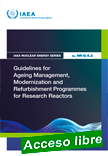 |
Guidelines for Ageing Management, Modernization and Refurbishment Programmes for Research Reactors
IAEA Nuclear Energy Series No. NR-G-5.2 ¦ English ¦ STI/PUB/2069 ¦ 168 pages ¦ Date published: 2024
This publication provides detailed information for operating organizations of research reactors on methodologies to manage existing and potential ageing effects and the degradation of structures, systems and components. Practical guidance is presented on managing the effects of ageing on civil structures, on mechanical, electrical and instrumentation and control systems, and on reactor components important for safety and operation.
|
This publication also provides information on how to establish and implement an effective and systematic ageing management programme, including the management of modifications, modernizations and refurbishments. Several practical examples of successful ageing management programmes executed in operating research reactors are included as annexes.
|
 |
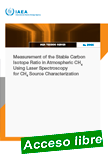 |
Measurement of the Stable Carbon Isotope Ratio in Atmospheric CH4 Using Laser Spectroscopy for CH4 Source Characterization
IAEA-TECDOC-2066 ¦ English ¦ 94 pages ¦ Date published: 2024
Atmospheric methane is the second most important anthropogenic greenhouse gas after carbon dioxide. The present atmospheric burden of methane is unprecedented in the last 800,000 years and has almost tripled since the onset of the industrial revolution.
|
Arising from an interregional technical cooperation project aiming to assist countries in building capacity in stable isotopes analysis of atmospheric greenhouse gases and accurately determine their source, this publication provides high-level guidance to laboratories that are new to the use of optical instruments to measure methane and its stable carbon isotope ratios. The publication covers analytical infrastructure, sampling strategies, as well as techniques for measurement, calibration, data processing analysis and interpretation. Further emphasis is on technical solutions that ensure that observations are accurate and comparable, as well as on sustainable data management techniques, and quality control procedures, to maximize the impact of newly generated data.
|
 |
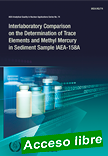 |
Interlaboratory Comparison on the Determination of Trace Elements and Methyl Mercury in Sediment Sample IAEA-158A
IAEA Analytical Quality in Nuclear Applications Series No. 74 ¦ English ¦ 57 pages ¦ Date published: 2024
The identification of environmental pollution is based on monitoring campaigns that periodically
assess the quality of seawater, marine sediments and biota samples. The reliability and comparability
of analytical results produced in this context are crucial for the management of the marine
environment in general, for example when taking decisions and meaningful actions in relation to
remediation policies.
|
This publication summarizes the results of the interlaboratory comparison on the determination of trace elements and methylmercury in a sediment sample organized in 2022.
|
 |
| |
|
|

|
|
|
| |
|
|
| |
| |
|
|
| |
| |
|
|
| |
| |
|
|
|
| |
| |
